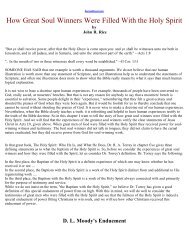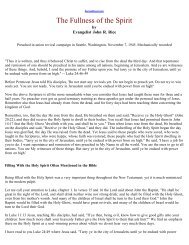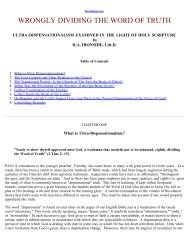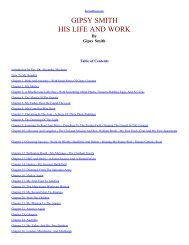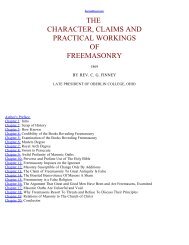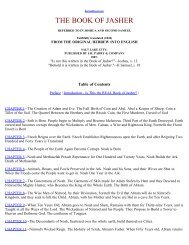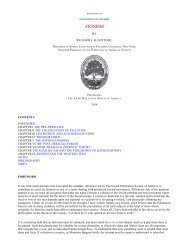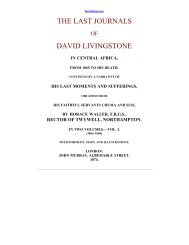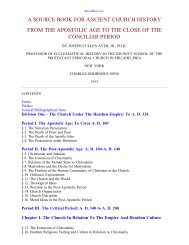Legends of Babylon and Egypt in Relation to Hebrew Tradition.pdf
Legends of Babylon and Egypt in Relation to Hebrew Tradition.pdf
Legends of Babylon and Egypt in Relation to Hebrew Tradition.pdf
You also want an ePaper? Increase the reach of your titles
YUMPU automatically turns print PDFs into web optimized ePapers that Google loves.
explicable only on that hypothesis. In magical compositions <strong>of</strong> the later period <strong>in</strong>tended for recitation, the sign for<br />
"Incantation" is usually prefixed. Unfortunately the beg<strong>in</strong>n<strong>in</strong>g <strong>of</strong> our text is want<strong>in</strong>g; but its open<strong>in</strong>g words are given <strong>in</strong><br />
the colophon, or title, which is engraved on the left-h<strong>and</strong> edge <strong>of</strong> the tablet, <strong>and</strong> it is possible that the traces <strong>of</strong> the first<br />
sign there are <strong>to</strong> be read as EN, "Incantation".[1] Should a re-exam<strong>in</strong>ation <strong>of</strong> the tablet establish this read<strong>in</strong>g <strong>of</strong> the<br />
word, we should have def<strong>in</strong>ite pro<strong>of</strong> <strong>of</strong> the suggested magical sett<strong>in</strong>g <strong>of</strong> the narrative. But even if we assume its<br />
absence, that would not <strong>in</strong>validate the arguments that can be adduced <strong>in</strong> favour <strong>of</strong> recogniz<strong>in</strong>g the existence <strong>of</strong> a<br />
magical element, for they are based on <strong>in</strong>ternal evidence <strong>and</strong> enable us <strong>to</strong> expla<strong>in</strong> certa<strong>in</strong> features which are<br />
<strong>in</strong>explicable on Dr. Poebel's hypothesis. Moreover, we shall later on exam<strong>in</strong>e another <strong>of</strong> the newly published Sumerian<br />
compositions from Nippur, which is not only semi-epical <strong>in</strong> character, but is <strong>of</strong> precisely the same shape, script, <strong>and</strong><br />
period as our text, <strong>and</strong> is very probably a tablet <strong>of</strong> the same series. There also the open<strong>in</strong>g signs <strong>of</strong> the text are want<strong>in</strong>g,<br />
but far more <strong>of</strong> its contents are preserved <strong>and</strong> they present unmistakable traces <strong>of</strong> magical use. Its evidence, as that <strong>of</strong><br />
a parallel text, may therefore be cited <strong>in</strong> support <strong>of</strong> the present contention. It may be added that <strong>in</strong> Sumerian magical<br />
compositions <strong>of</strong> this early period, <strong>of</strong> which we have not yet recovered many quite obvious examples, it is possible that<br />
the prefix "Incantation" was not so <strong>in</strong>variable as <strong>in</strong> the later magical literature.<br />
[1] Cf. Poebel, /Hist. Texts/, p. 63, <strong>and</strong> /Hist. <strong>and</strong> Gram. Texts/, pl. i. In the pho<strong>to</strong>graphic reproduction <strong>of</strong> the edges <strong>of</strong><br />
the tablet given <strong>in</strong> the latter volume, pl. lxxxix, the traces <strong>of</strong> the sign suggest the read<strong>in</strong>g EN (= Sem. /šiptu/,<br />
"<strong>in</strong>cantation"). But the sign may very possibly be read AN. In the latter case we may read, <strong>in</strong> the traces <strong>of</strong> the two<br />
sign-groups at the beg<strong>in</strong>n<strong>in</strong>g <strong>of</strong> the text, the names <strong>of</strong> both Anu <strong>and</strong> Enlil, who appear so frequently as the two<br />
presid<strong>in</strong>g deities <strong>in</strong> the myth.<br />
It has already been remarked that only the lower half <strong>of</strong> our tablet has been recovered, <strong>and</strong> that consequently a number<br />
<strong>of</strong> gaps occur <strong>in</strong> the text. On the obverse the upper portion <strong>of</strong> each <strong>of</strong> the first three columns is miss<strong>in</strong>g, while <strong>of</strong> the<br />
rema<strong>in</strong><strong>in</strong>g three columns, which are <strong>in</strong>scribed upon the reverse, the upper portions only are preserved. This difference<br />
<strong>in</strong> the relative positions <strong>of</strong> the textual fragments recovered is due <strong>to</strong> the fact that Sumerian scribes, like their later<br />
<strong>Babylon</strong>ian <strong>and</strong> Assyrian imita<strong>to</strong>rs, when they had f<strong>in</strong>ished writ<strong>in</strong>g the obverse <strong>of</strong> a tablet, turned it over from bot<strong>to</strong>m<br />
<strong>to</strong> <strong>to</strong>p--not, as we should turn a sheet <strong>of</strong> paper, from right <strong>to</strong> left. But <strong>in</strong> spite <strong>of</strong> the lacunae, the sequence <strong>of</strong> events<br />
related <strong>in</strong> the mythological narrative may be followed without difficulty, s<strong>in</strong>ce the ma<strong>in</strong> outl<strong>in</strong>e <strong>of</strong> the s<strong>to</strong>ry is already<br />
familiar enough from the versions <strong>of</strong> the Semitic- <strong>Babylon</strong>ian scribes <strong>and</strong> <strong>of</strong> Berossus. Some uncerta<strong>in</strong>ties naturally<br />
rema<strong>in</strong> as <strong>to</strong> what exactly was <strong>in</strong>cluded <strong>in</strong> the miss<strong>in</strong>g portions <strong>of</strong> the tablet; but the more important episodes are<br />
fortunately recounted <strong>in</strong> the extant fragments, <strong>and</strong> these suffice for a def<strong>in</strong>ition <strong>of</strong> the dist<strong>in</strong>ctive character <strong>of</strong> the<br />
Sumerian Version. In view <strong>of</strong> its literary importance it may be advisable <strong>to</strong> attempt a somewhat detailed discussion <strong>of</strong><br />
its contents, column by column;[1] <strong>and</strong> the analysis may be most conveniently divided <strong>in</strong><strong>to</strong> numbered sections, each <strong>of</strong><br />
which refers <strong>to</strong> one <strong>of</strong> the six columns <strong>of</strong> the tablet. The description <strong>of</strong> the First Column will serve <strong>to</strong> establish the<br />
general character <strong>of</strong> the text. Through the analysis <strong>of</strong> the tablet parallels <strong>and</strong> contrasts will be noted with the<br />
<strong>Babylon</strong>ian <strong>and</strong> <strong>Hebrew</strong> Versions. It will then be possible <strong>to</strong> summarise, on a surer foundation, the literary his<strong>to</strong>ry <strong>of</strong><br />
the traditions, <strong>and</strong> f<strong>in</strong>ally <strong>to</strong> estimate the effect <strong>of</strong> our new evidence upon current theories as <strong>to</strong> the orig<strong>in</strong> <strong>and</strong> wide<br />
dispersion <strong>of</strong> Deluge s<strong>to</strong>ries.<br />
[1] In the lecture as delivered the contents <strong>of</strong> each column were necessarily summarized rather briefly, <strong>and</strong> conclusions<br />
were given without discussion <strong>of</strong> the evidence.<br />
The follow<strong>in</strong>g head<strong>in</strong>gs, under which the six numbered sections may be arranged, <strong>in</strong>dicate the contents <strong>of</strong> each column<br />
<strong>and</strong> show at a glance the ma<strong>in</strong> features <strong>of</strong> the Sumerian Version:<br />
I. Introduction <strong>to</strong> the Myth, <strong>and</strong> account <strong>of</strong> Creation. II. The Antediluvian Cities. III. The Council <strong>of</strong> the Gods, <strong>and</strong><br />
Ziusudu's piety. IV. The Dream-Warn<strong>in</strong>g. V. The Deluge, the Escape <strong>of</strong> the Great Boat, <strong>and</strong> the Sacrifice <strong>to</strong> the Sungod.<br />
VI. The Propitiation <strong>of</strong> the Angry Gods, <strong>and</strong> Ziusudu's Immortality.<br />
I. INTRODUCTION TO THE MYTH, AND ACCOUNT OF CREATION<br />
The beg<strong>in</strong>n<strong>in</strong>g <strong>of</strong> the text is want<strong>in</strong>g, <strong>and</strong> the earliest l<strong>in</strong>es preserved <strong>of</strong> the First Column open with the clos<strong>in</strong>g<br />
sentences <strong>of</strong> a speech, probably by the chief <strong>of</strong> the four creat<strong>in</strong>g deities, who are later on referred <strong>to</strong> by name. In it<br />
there is a reference <strong>to</strong> a future destruction <strong>of</strong> mank<strong>in</strong>d, but the context is broken; the l<strong>in</strong>es <strong>in</strong> question beg<strong>in</strong>:



